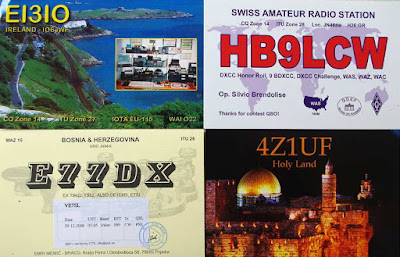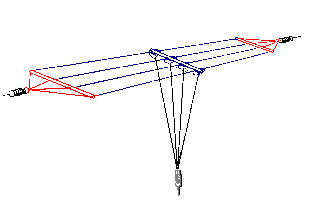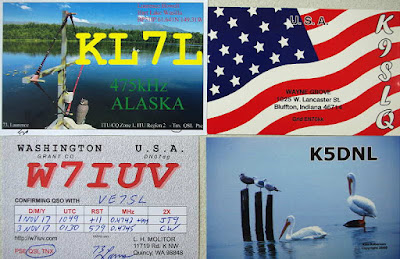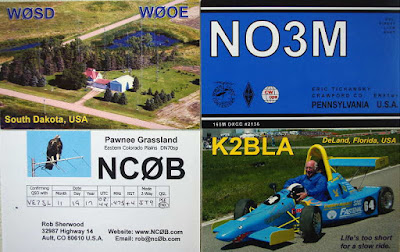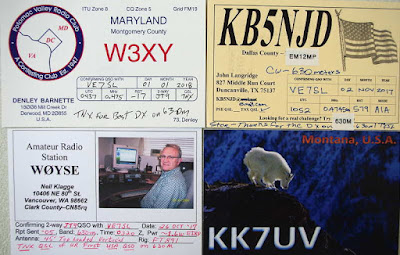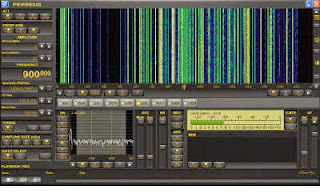Author Archive
 Evaluating Online SDRs For MW Capabilities
Evaluating Online SDRs For MW Capabilities
 |
| courtesy: https://sdr.hu/ |
In a previous blog I described the amazing KiwiSDR network of online receivers. A quick check of the network as I write today's blog shows that there are presently 207 active online receivers distributed throughout the world!
Over the past year, there has been a growing interest in using many of the online receivers during the monthly CLE NDB listening events, all focused on the medium frequency (MF) part off the spectrum just below the AM broadcast band. Some use the SDRs to search for unlogged beacons while others use them because their home locations have become too noisy to hear anything using their own radios, a growing problem for listeners everywhere.
One ardent NDB DXer, Dan Petersen, W7OIL, (located in Vancouver, WA) has become a regular Kiwi network user as well as a regular contributor to the very valuable RNA / REU / RWW list of worldwide beacon activity. Over the past year, Dan has been keeping careful notes on not only what he has been hearing but also on how well many of the online radios perform on the MF NDB band.
As it turns out, many receivers perform very well on the HF bands but are dreadfully inadequate when it comes to the medium wave frequencies. Many are plagued with high noise levels, switching power supply signals, intermod or inadequate antenna systems, making them unusable for weak signal DX work below the broadcast band.
Other receivers however, are superb performers, as evidenced by their quiet low noise locations and well engineered antennas, providing the ideal opportunity to conduct some serious medium wave weak signal detection.
Dan has now produced the start of an ongoing guide, mainly focusing on the various Kiwi Network receivers that he has tested, rating them with regard to sensitivity and local noise, when used in the 200 - 500 kHz range only.
His SDR EVALUATION LIST (in .pdf form) can be downloaded from here, and will be updated periodically, as other online receivers are evaluated.
If you are plagued with local noise on the MF band yet would like to do some weak signal DXing, especially during the monthly NDB CLE activities, the online SDRs may be of interest to you. With Dan's helpful groundwork already giving you a leg up, hopefully you can give them a try sometime soon!
*********************************
Speaking of monthly CLEs ... the recently completed weekend event (CLE232), was a rough one, with worldwide lightning noise as well as an active geomagnetic field hampering reception for all participants. In North America, all three nights were terribly noisy and propagation was poor.
As is so often the case, Friday night was the 'best' of the three nights but only 18 stations were heard here. My log is shown below.
It was nice to hear POA in Pahoa, Hawaii, still going strong as it is located close to the present volcanic eruptions.
All signals were heard on a Perseus SDR feeding an inverted-L antenna, resonated to 300kHz.
26 09:00 325.0 YJQ Bella Bella (Campbell Island), BC, CAN
26 09:00 326.0 YQK Kenora, ON, CAN
26 10:00 326.0 DC Princeton Municipal Apt, BC, CAN
26 06:00 328.0 YTL Big Trout Lake, ON, CAN
26 09:00 328.0 LAC 'Lacomas' Fort Lewis, WA, USA
26 09:00 328.0 5J Coronation, AB, CAN
26 06:00 329.0 YHN Hornepayne, ON, CAN
26 09:00 329.0 YEK Arviat, NU, CAN
26 09:00 329.0 X2 Athabasca, AB, CAN
26 10:00 329.0 PMV Plattsmouth, NE, USA
26 09:00 329.0 PJ Robinson (Whitehorse), YT, CAN
26 09:00 330.0 0O UNID, XUU
26 09:00 332.0 XT Terrace, BC, CAN
26 09:00 332.0 WC White Rock (Abbotsford), BC, CAN
26 10:00 332.0 VVV Ortonville Municipal Apt, MN, USA
27 09:00 332.0 VT Buffalo Narrows, SK, CAN
26 12:00 332.0 POA Pahoa - Hawaii Island, HWA
26 06:00 334.0 YER Fort Severn, ON, CAN
 Hunting For NDBs In CLE 232
Hunting For NDBs In CLE 232
| YEK - 329kHz courtesy: www.ve3gop.com/ |
This coming weekend will see another monthly CLE challenge. This time the hunting grounds will be 320.0 - 334.9 kHz.
For those unfamiliar with this monthly activity, a 'CLE' is a 'Co-ordinated Listening Event', as NDB DXers around the world focus their listening time on one small slice of the NDB spectrum.
A nice challenge in this one is to hear the Arviat NDB, located in Nunavut on the western shores of Hudson Bay.
'YEK', on 329 kHz runs 500W into a 100' vertical and it's well-heard throughout North America and many parts of Europe under the right conditions. Listen for its upper-sideband CW identifier (with your receiver in the CW mode) on 329.421 kHz.
Propagation has been very good on the MF band recently but at this time of the year, good listening is often hampered by a lot of lightning activity. Hopefully that will not be the case this coming weekend but today's map shows what we may be up against!
 |
| courtesy: http://thunderstorm.vaisala.com/explorer.html |
If you are interested in building a system for the new (U.S.) 630m band, the CLE will give you the chance to test out your MF receiving capabilities and compare against what others in your area might be hearing.
When tuning for NDBs, put your receiver in the CW mode and listen for the NDB's CW identifier, repeated every few seconds. Listen for U.S. NDB identifiers approximately 1 kHz higher or lower than the published transmitted frequency since these beacons are modulated with a 1020 Hz tone approximately.
For example, 'AA' near Fargo, ND, transmits on 365 kHz and its upper sideband CW identifier is tuned at 366.025 kHz while its lower sideband CW ident can be tuned at 363.946 kHz. Its USB tone is actually 1025 Hz while its LSB tone is 1054 Hz.
Often, one sideband will be much stronger than the other so if you don't hear the first one, try listening on the other sideband.
Canadian NDBs normally have an USB tone only, usually very close to 400 Hz. They also have a long dash (keydown) following the CW identifier.
All NDBs heard in North America will be listed in the RNA database (updated daily) while those heard in Europe may be found in the REU database. Beacons heard outside of these regions will be found in the RWW database.
From CLE organizer Brian Keyte, G3SIA, comes the details:
Hello all
Our next Co-ordinated Listening Event is less than a week away.
It is an ideal one for new listeners as well as for regulars:
Days: Friday 25 May - Monday 28 May
Times: Start and End at midday, your LOCAL time
Range: 320.0 - 334.9 kHz
It's straightforward - just log the NDBs that you can identify having their
nominal frequencies in the range, plus any UNIDs that you come across
there. We last concentrated on these frequencies during CLE216 in
February 2017.
We'll be near the DGPS beacons range and some of us, especially in North
America, may hear a few, but please don't report them in this CLE.
73
Brian
-----------------------------------------------------------------
From: Brian Keyte G3SIA ndbcle'at'gmail.com
Location: Surrey, SE England (CLE coordinator)
-----------------------------------------------------------------
If you are interested in some remote listening - maybe due to local difficulties - you could use any one remote receiver for your loggings, stating its location and with the owner’s permission if required. A remote listener may NOT also use another receiver, local or remote, to make further loggings for the same CLE.
-------------------------------------------------------------------
These listening events serve several purposes. They:
*** NEWS FLASH ***
The Yahoo ndblist Group has been moved to Groups.io and The NDB List Group will now be found there! The very active group is a great place to learn more about the 'Art of NDB DXing' or to meet other listeners in your region. There is a lot of good information available there and new members are always very welcome. As well, you can follow the results of other CLE participants from night to night as propagation is always an active topic of discussion.
You need not be an NDB List member to participate in the CLEs and all reports, no matter how small, are of much value to the organizers.
Remember - 'First-time' logs are always VERY welcome!
Reports may be sent to the NDB List Group or e-mailed to CLE co-ordinator, Brian Keyte (G3SIA), whose address appears above. If you are a member of the group, all final results will also be e-mailed and posted there.
Please ... give the CLE a try ... then let us know what NDB's can be heard from your location! Your report can then be added to the worldwide database to help keep it up-to-date.
Have fun and good hunting!
- determine, worldwide, which beacons are actually in service and on-the-air so the online database can be kept up-to-date
- determine, worldwide, which beacons are out-of-service or have gone silent since the last CLE covering this range
- will indicate the state of propagation conditions at the various participant locations
- will give you an indication of how well your LF/MF receiving system is working
- give participants a fun yet challenging activity to keep their listening skills honed
*** NEWS FLASH ***
The Yahoo ndblist Group has been moved to Groups.io and The NDB List Group will now be found there! The very active group is a great place to learn more about the 'Art of NDB DXing' or to meet other listeners in your region. There is a lot of good information available there and new members are always very welcome. As well, you can follow the results of other CLE participants from night to night as propagation is always an active topic of discussion.
You need not be an NDB List member to participate in the CLEs and all reports, no matter how small, are of much value to the organizers.
Remember - 'First-time' logs are always VERY welcome!
Reports may be sent to the NDB List Group or e-mailed to CLE co-ordinator, Brian Keyte (G3SIA), whose address appears above. If you are a member of the group, all final results will also be e-mailed and posted there.
Please ... give the CLE a try ... then let us know what NDB's can be heard from your location! Your report can then be added to the worldwide database to help keep it up-to-date.
Have fun and good hunting!
 ‘CQ BR’ – It’s “Bug Roundup” Weekend!
‘CQ BR’ – It’s “Bug Roundup” Weekend!
Ever since earning my ticket as a teenager back in '63, almost all of my on-air activity has been focused on CW ... I've always loved it.
Back when I first got on the air there were very few amateurs using keyers. Most used bugs and the remainder used hand keys. It was very easy to tune across the band and identify any of the locals just by the sound of their fist ... like snowflakes, no two were the same. The same went for most stations that were very active. DX or otherwise, one could usually tell who it was, long before the call signs were sent.
So much has changed now with the almost exclusive use of electronic keyers and everyone pretty much sounds the same, which is rather unfortunate I think.
Once my interest in building vintage-style vacuum-tube transmitters evolved, my interest in bugs was reactivated and over the years I have purchased a few more.
I'll do everything I can to promote and encourage the use of CW and especially hand-generated CW. That's why I was excited, once again, to read a recent e-mail from W6SFM, posted to several lists that I read, announcing the Bug Roundup!
The Samuel F. Morse Amateur Radio Club, a Sacramento, California based CW enthusiast club wanted a special time to bring bug operators together on the air.
In the same spirit as ARRL's Straight Key Night, participants are encouraged to make simple, conversational, “chewing-the-fat” QSOs using their bug type key.
This is an opportunity to exercise, share and exhibit your personalized fist. This is NOT a contest. However, there is a very easy and quick registration form found at https://w6sfm.com/bug-roundup/.
Once you've optionally registered for the event simply Call "CQ BR" so folks know you are a Bug Roundup Participant. So lets grab that bug, clean those contacts, and let’er fly! We want to hear that “Banana Boat / Lake Erie Swing" or that commercial KPH/WCC quality fist.
Reserve the date! The event begins on Friday May 18th (00:00 UTC) and concludes Sunday May 20th (00:00 UTC)
That's 5:00 PM Friday evening until 5 PM Pacific Time Sunday (LOCAL)
For more information, to register your station, and to help assist in spotting, potentially increasing QSOs, an On-line chat window link can be found near the bottom of Bug Roundup home page located at https://w6sfm.com/bug-roundup/
We hope to hear you all on the air! 73,

| courtesy: arrl.org |
Please see if you can squeeze-in a few hours of nice old bug-generated CW as the present digital craze is taking a big bite out of conventional CW activity it seems. Hopefully this is only temporary!
 FCC’s Pirate Purge Continues
FCC’s Pirate Purge Continues

For some reason, the FCC continues to pour money into its hell-bent roundup of FM pirate broadcasters! I suspect much of this 'tough stance' is more politically motivated than for the reasons that they state, but the FCC seems to have plenty of will-power and the necessary funding ... it's too bad that they couldn't put the same zeal into getting on top of or making a start on the huge growing noise problem throughout the radio spectrum. I guess rounding up pirates is much easier than tackling the far more important noise issues, now growing so rapidly that many radio amateurs just throw up their hands in surrender and close up shop for good. Even commercial users of the spectrum are being negatively affected by the growing noise floor, as the growing Internet of Things connected devices produce even more radio crud.
It now seems that the FCC may get a further boost in its crackdown if a new bipartisan proposed federal law becomes reality. A May 9, 2018, article in Radio World reports the tabling of the new bill in the US Congress called the PIRATE Act or "Preventing Illegal Radio Abuse Through Enforcement Act". It would also be nice to see the PAIN Act (Preventing All Illegal Noise) in the RF spectrum but I see no Washington appetite for this much-needed FCC oversight.
The continued obsession for rounding up FM pirate broadcasters is fascinating in its own right. "It is time to take these pirates off the air by hiking the penalties and working with the Federal Communication Commission on enforcement", stated Rep. Leonard Lance (R-NJ).
"As reported in Radio World, the PIRATE Act proposes to hike the fine for violations to as much as $100,000 per day, with a maximum fine of $2 million. The rules currently allow the FCC to impose a maximum daily penalty of about $19,200 per day. At a Congressional hearing on the bill in March, New York State Broadcasters Association President David Donovan told lawmakers that illegal operators are undermining the nation’s Emergency Alert System, causing invasive and insidious interference, pose potential public health problems due to overexposure to radio frequency radiation, and interfere with airport communications."
It is apparent from reading investigative reports, that each acted-upon complaint requires a substantial investment of time and money as in the April 24 Notice of Apparent Liability for a case in Paterson, New Jersey ... it seems that NJ and NY are 'pirate hotbeds'. By the end of the investigation, a team of fully-equipped FCC field agents had visited the pirate's site(s) on eight different occasions, a considerable investment in time, energy and money. In the end, a $25,000 penalty has been proposed for the offender.
I am not a fan of illegal pirate radio broadcasting in any form but the reasons stated by the FCC for the ongoing pirate purges seem somewhat shaky. In all of the investigative reports that I've read, I have yet to find any that were reported to cause "interference with airport communications" and I question the assertion that the low power levels used by most pirates are going to "pose potential public health problems due to overexposure to radio frequency radiation". One more likely reason may be the strong lobby pressure from broadcasters who see the possible loss of advertising revenue. I'm sure that many Washington electees receive healthy campaign donations from state broadcasters as well.
Although many pirate radio ops seemingly solicit advertising revenue, overall it can't be much of a threat to mainstream broadcasters. Is it just the NAB Washington lobby that is fuelling the FCC pirate craze or is it muscle-flexing from the new administration, wanting to look tough on "crime" and radio-pirates are just easy low-hanging fruit? I suspect that it may be more of the latter.
The FCC's 'Pirate Action' postings make for interesting reading as does the fascinating Westword article on pirate radio activity in Ward, Colorado, and the recent attempted FCC take-down of stations in operation since 1997!
There's no question that a lot of FCC resources are being used to eliminate unlicenced QRM. What will it take to see the same attack on unlicenced QRN as well?
 Will The Sun Get Too Quiet For Topband DX?
Will The Sun Get Too Quiet For Topband DX?

Those of us that like to hunt European DX on 160m from the west coast know that the best time for this is during the 'solar low' years, those quiet periods between the end of one solar cycle and the beginning of the next.
From the west coast, openings to Europe on 160m are not something that happens with much regularity and, unlike the more frequent paths to Europe enjoyed from the east coast, are almost exclusively limited to this quieter part of the solar cycle. The weakening of the Sun's magnetic field at these times allows for less prop-killing D and E-layer signal absorption, particularly through the northern auroral zone path required from the west coast.
In his October, 2016, posting to the Topband reflector, propagation guru Carl Luetzelschwab, (K9LA), suggested that the coming years of solar lows may actually be too low and that because of the likely unprecedented low levels not seen in our lifetimes, the planet could receive higher cosmic-ray bombardment than normally associated with these periods.
"Since galactic cosmic rays are mostly *very energetic* protons, they can get down to low atmospheric altitudes, causing collisional ionization in the D region (and lower E region). A cursory estimate using cosmic ray ionization rates confirms more ionization in the lower atmosphere. 160m is not very tolerant of more absorption, so we may see an adverse effect of the weakened solar magnetic field."
K9LA's Topband comments seems to have its roots in his May, 2015 article, "What's Going On With-160 Meters?", where he compares the solar minimum period between Cycles 22 and 23 to the minimum years between Cycles 23 and 24. Carl noted that the best 160m propagation period that he had seen in his lifetime was during the years between Cycle 22 and 23 and pondered why, during the even deeper prolonged low between Cycles 23 and 24, was it not producing the same levels of great propagation observed 11 years earlier. One possibility he puts forward was that ...
" ... it involves galactic cosmic rays (GCRs). At solar maximum, the Sun is more active, causing more geomagnetic field activity that is believed to be detrimental to 160-Meter propagation. Coupled with the Sun being more active is the fact that the Sun's magnetic field is stronger, which shields the Earth from galactic cosmic rays. Going the other way, when we're at solar minimum, the Sun's magnetic field is weakest, letting in more cosmic rays."
His graph shows the yearly trend of only the low Ap index days (geomagnetically quiet) versus smoothed sunspot numbers for several recent cycles. The blue line plots the trend of low Ap index values with the black line showing the smoothed values; the red line indicates the smoothed sunspot number (solar activity levels).
 |
| source: http://k9la.us/May15_What_s_Going_On_with_160-Meters.pdf |
Carl's earlier observations indicating that the best 160m propagation he had ever observed was during the low period between Cycle 22 and 23 and not during the much quieter low period between Cycle 23 and 24 are very much different than my own ... perhaps because of our different locations.
From the west coast, the most challenging topband path is over the pole to Europe. This only occurs during 'best propagation' periods as this path will only open during prolonged periods of very low geomagnetic activity. Unlike Carl's path to Europe, west coast signals need to traverse the signal-killing auroral zone.
During the first low period, I did experience several openings to Europe but nothing compared to what they were during the second low period, between Cycles 23 and 24, the one Carl did not experience propagation as good as the previous low. For several winters in a row, during the 23-24 low, I often found night after night of amazing propagation to Europe, the quality of which I had never heard before. Interestingly, on almost all of these nights, there were no other signals on the band but Europeans and nearby Washington or Oregon state W7s ... no signals at all from the rest of North America. At times it mimicked the sound of 20m CW to Europe, with signals often reaching S9 on my FT-1000 S-meter. I even worked one SM station on CW while running just 10W output!
With this long intense low, cosmic ray bombardment should have been at an all time high ... maybe it was, but it didn't seem to be bothering the west coast path to Europe, via the seemingly dormant auroral zone.
I was prompted to address this topic after reading a recent report on the GeoSpace website, siting a new study led by Nathan Schwadron, professor of physics at the University of New Hampshire’s Space Science Center. In the study, recently published in the journal Space Weather, a publication of the American Geophysical Union, the researchers found that large fluxes in Galactic Cosmic Rays (GCR) are rising faster and are on a path to exceed any other recorded time in the space age.
The author's study predicted a 20% increase in radiation bombardment but their newest research shows current conditions exceed their predictions by about 10 percent, showing the radiation environment is worsening even more than expected.
With cosmic ray levels now predicted to increase by a whopping 30%, Carl and the rest of us may soon get some clarity on his original postulation that "maybe a solar minimum can be too deep for 160 meters."
With the next few cycles expected to be even poorer than the present one, the large increase in radiation levels from space may have profound impacts on more than just propagation ... satellites and, with a new appetite to return human activity to the moon, astronauts could be exposed to much higher radiation levels than ever before.
The next few years of (ultra?) solar-quiet should be very interesting!
 630m – Winter One
630m – Winter One
Although Canadian amateurs have had the 630m band for a few years now, the arrival of U.S. amateurs on the band last fall has been a game changer in terms of activity ... it's almost like starting fresh once again, hence the "Winter One" title!
The steady arrival of new stations on the band was exciting to see and the increase in activity made nightly band-checking mandatory in order to keep up with the new arrivals. Not totally unexpected, a high percentage of the new stations were located in the eastern part of the country where ham populations are higher, giving even more incentive to watch propagation trends for those 'special' nights to put some of the new arrivals in the log.
Over the winter DX season I worked 37 'new' U.S. stations in 23 different states. Of these 23 states, 11 were on CW while 12 were on JT9. Many of the JT9 contacts could have been made on CW at the time, had that been the operating mode chosen.
Hopefully the band will see an increase in CW activity next year as activity continues to grow. It is certainly much easier to get a capable CW signal on the air than a digital one and that is what many decided to do to get a quick start, while going the transverter route was the method chosen by most.
After being active all winter, the biggest surprise for me about 630m was just how little actual power is needed to exchange coast-to-coast signals, especially when using the weak-signal digital JT9 QSO mode.
Almost every new station that I worked was running less than 100 watts of total per output (TPO). A large number of these stations were in the 20 watt TPO range which I really found astounding, considering the relatively poor efficiencies of typical backyard antenna systems on this band. Propagation, always the great equalizer, was certainly playing a major role at times and watching conditions change from night to night was an education in itself.
As on most bands, allowable power is limited, but on LF and MF, the limits are stated in EIRP and not TPO. Hams are limited to 5W EIRP on 630m which may not sound like much but a large number of the stations worked this winter were worked while I was running around 2-3W EIRP which often seems to be plenty when using JT9.
Although Canada's west coast is now well-represented on 630m, it would be really great to see some interest and station building from provinces to the east ... VE6, VE5, VE4 ... The fast-approaching warmer weather should provide the ideal opportunity to get any needed antenna work squared away before the next DX season begins along with its anti-antenna building winter weather!
If you are one of many amateurs that may have been contemplating some 630m work but were discouraged about antenna sizes or having to generate gobs of power, hopefully the above information will encourage you to get on the band and join the fun.
You can find more information that may be helpful in your quest via the 630m links on the right side of my blog page or by clicking here.
The steady arrival of new stations on the band was exciting to see and the increase in activity made nightly band-checking mandatory in order to keep up with the new arrivals. Not totally unexpected, a high percentage of the new stations were located in the eastern part of the country where ham populations are higher, giving even more incentive to watch propagation trends for those 'special' nights to put some of the new arrivals in the log.
Over the winter DX season I worked 37 'new' U.S. stations in 23 different states. Of these 23 states, 11 were on CW while 12 were on JT9. Many of the JT9 contacts could have been made on CW at the time, had that been the operating mode chosen.
Hopefully the band will see an increase in CW activity next year as activity continues to grow. It is certainly much easier to get a capable CW signal on the air than a digital one and that is what many decided to do to get a quick start, while going the transverter route was the method chosen by most.
After being active all winter, the biggest surprise for me about 630m was just how little actual power is needed to exchange coast-to-coast signals, especially when using the weak-signal digital JT9 QSO mode.
Almost every new station that I worked was running less than 100 watts of total per output (TPO). A large number of these stations were in the 20 watt TPO range which I really found astounding, considering the relatively poor efficiencies of typical backyard antenna systems on this band. Propagation, always the great equalizer, was certainly playing a major role at times and watching conditions change from night to night was an education in itself.
 |
| K9MRI - 22W / 72' vertical wire / 140' tophat (72' x -140') |
 |
| K9FD/KH6 - 100W / 70' x 70' inverted-L |
 |
| K0KE (CW) - 75W / 70' x 50' inverted-L |
 |
| WA9CGZ - 100W / base-loaded 160m inverted-L |
 |
| N1BUG - 20W / inverted-L |
 |
| KC3OL - 15W / base-loaded 'T' |
 |
| K8TV - 3W eirp / 55' x 150' 'T' |
 |
| K9KFR - 20W / 80' wire vertical |
 |
| KA7OEI (CW) - 25W / 200' circular loop at 30' |
 |
| K5DOG - 16W / 275' vertical loop |
 |
| KC4SIT - 60W / inverted-L |
Although Canada's west coast is now well-represented on 630m, it would be really great to see some interest and station building from provinces to the east ... VE6, VE5, VE4 ... The fast-approaching warmer weather should provide the ideal opportunity to get any needed antenna work squared away before the next DX season begins along with its anti-antenna building winter weather!
If you are one of many amateurs that may have been contemplating some 630m work but were discouraged about antenna sizes or having to generate gobs of power, hopefully the above information will encourage you to get on the band and join the fun.
You can find more information that may be helpful in your quest via the 630m links on the right side of my blog page or by clicking here.
 CLE 230 Results
CLE 230 Results
Last weekend's CLE 230 overall results have now been tabulated. Reports from European NDB hunters and those from North America and the rest of the world may all be found here at the NDB List info website.
If you have joined the NDB List group, a copy of these will have already been sent to your mailbox.
It seems that compared to the last time these same frequencies were searched (CLE 213 Nov '16), my results were a little poorer, with 36 beacons heard this time versus 52 for the previous effort.
Propagation varied over the three night event depending upon what part of the world you were listening from and as usual, when there has been some recent coronal hole induced geomagnetic disturbance, the further away from the auroral zone you were, the better the prop seemed to be. The third and final night saw summer-like lightning noise for most North American listeners and the next several CLE weekends will be lucky to escape these rising levels until late in the fall ... but don't give up as there can be some great propagation in the summer and those quiet nights do come around when you least expect them.
In spite of the poor propagation here, there were some unusual quirks. Many of the 25 watt, normally easy NDBs from the central and southern states, were missing in action ... yet on all three nights, both FIS in Key West, Florida and SQT, up the coast on Florida's central eastern shoreline, were easy copy for several hours.
I can only guess that the reason for this is that both of these are 'big' beacons ... big antennas and power in the 300W plus class. They just managed to power through in spite of the poor propagation.
The other surprise was a loud signal on all three nights from FS in Sioux Falls, South Dakota, yet there was not even a hint of many of the other regular midwestern stations. Its reported 300W and 60' vertical is no doubt the reason.
How DD in Columbus, Ohio managed to sneek through is a bit of a mystery but it looks like her 50W and classic 'T' was enough to do the trick.
I managed only 36 stations but spent little time on Friday since conditions were truly dreadful.
25 04:00 240.0 BVS Burlington, WA, USA
25 08:00 241.0 YLL Lloydminster, AB, CAN
25 04:00 242.0 ZT Port Hardy, BC, CAN
25 04:00 242.0 XC Cranbrook, BC, CAN
25 07:00 244.0 TH Thompson, MB, CAN
25 05:00 245.0 YZE Gore Bay, ON, CAN
25 13:00 245.0 HNS Haines, ALS
25 06:00 245.0 FS Sioux Falls, SD, USA
25 08:00 245.0 CB Cambridge Bay, NU, CAN
25 08:00 245.0 AVQ Marana, AZ, USA
25 06:00 246.0 ZXJ Fort St. John, BC, CAN
25 07:00 248.0 ZZP Queen Charlotte Is, BC, CAN
25 04:00 248.0 WG Winnipeg, MB, CAN
25 07:00 248.0 QL Lethbridge, AB, CAN
25 07:00 248.0 QH Watson Lake, YT, CAN
25 09:00 248.0 PQF Mesquite, TX, USA
25 10:00 250.0 FO Flin Flon, MB, CAN
25 04:00 251.0 YCD Nanaimo, BC, CAN
25 11:00 251.0 OSE Bethel, ALS
25 04:00 251.0 AM Amarillo, TX, USA
25 07:00 253.0 GB Marshall, MN, USA
25 09:00 253.0 DD Commercial Point, OH, USA
25 09:00 254.0 ZYC Calgary, AB, CAN
25 09:00 254.0 SM Fort Smith, AB, CAN
25 09:00 254.0 EV Inuvik, NT, CAN
25 06:00 256.0 LSO Kelso, WA, USA
25 08:00 256.0 EB CFB Edmonton, AB, CAN
25 04:00 257.0 XE Saskatoon, SK, CAN
26 06:00 257.0 SQT Melbourne, FL, USA
25 04:00 257.0 LW Kelowna, BC, CAN
25 04:00 257.0 HCY Cowley, WY, USA
25 04:00 258.0 ZSJ Sandy Lake, ON, CAN
25 09:00 420.0 FQ East Chain, MN, USA
26 06:00 421.0 VLY McKenney, TX, USA
26 06:00 426.0 EN Council Bluffs, IA, USA
25 07:00 428.0 POH Pocahontas, IA, USA
As usual, my receiver of choice was the Perseus SDR in combination with my MF inverted-L, tuned to 300kHz.
The very active NDB Group.io List is a great place to learn more about the 'Art of NDB DXing' or to meet other listeners in your region. There is a lot of good information available there and new members are always very welcome. As well, you can follow the results of other CLE participants from night to night as propagation is always an active topic of discussion.
If you have joined the NDB List group, a copy of these will have already been sent to your mailbox.
It seems that compared to the last time these same frequencies were searched (CLE 213 Nov '16), my results were a little poorer, with 36 beacons heard this time versus 52 for the previous effort.
Propagation varied over the three night event depending upon what part of the world you were listening from and as usual, when there has been some recent coronal hole induced geomagnetic disturbance, the further away from the auroral zone you were, the better the prop seemed to be. The third and final night saw summer-like lightning noise for most North American listeners and the next several CLE weekends will be lucky to escape these rising levels until late in the fall ... but don't give up as there can be some great propagation in the summer and those quiet nights do come around when you least expect them.
In spite of the poor propagation here, there were some unusual quirks. Many of the 25 watt, normally easy NDBs from the central and southern states, were missing in action ... yet on all three nights, both FIS in Key West, Florida and SQT, up the coast on Florida's central eastern shoreline, were easy copy for several hours.
I can only guess that the reason for this is that both of these are 'big' beacons ... big antennas and power in the 300W plus class. They just managed to power through in spite of the poor propagation.
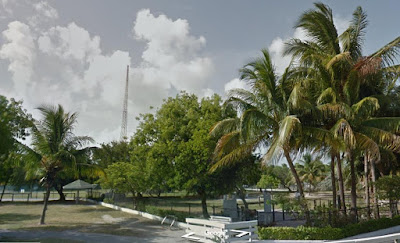 |
| FIS - 332 kHz Key West, Florida (aka: The 'Fish Hook' beacon) |
 |
| SQT - 257 kHz Melbourne, Florida |
The other surprise was a loud signal on all three nights from FS in Sioux Falls, South Dakota, yet there was not even a hint of many of the other regular midwestern stations. Its reported 300W and 60' vertical is no doubt the reason.
 |
| FS - 245 kHz Sioux Falls, South Dakota |
 |
| DD - 253 kHz Columbus Ohio |
I managed only 36 stations but spent little time on Friday since conditions were truly dreadful.
25 04:00 240.0 BVS Burlington, WA, USA
25 08:00 241.0 YLL Lloydminster, AB, CAN
25 04:00 242.0 ZT Port Hardy, BC, CAN
25 04:00 242.0 XC Cranbrook, BC, CAN
25 07:00 244.0 TH Thompson, MB, CAN
25 05:00 245.0 YZE Gore Bay, ON, CAN
25 13:00 245.0 HNS Haines, ALS
25 06:00 245.0 FS Sioux Falls, SD, USA
25 08:00 245.0 CB Cambridge Bay, NU, CAN
25 08:00 245.0 AVQ Marana, AZ, USA
25 06:00 246.0 ZXJ Fort St. John, BC, CAN
25 07:00 248.0 ZZP Queen Charlotte Is, BC, CAN
25 04:00 248.0 WG Winnipeg, MB, CAN
25 07:00 248.0 QL Lethbridge, AB, CAN
25 07:00 248.0 QH Watson Lake, YT, CAN
25 09:00 248.0 PQF Mesquite, TX, USA
25 10:00 250.0 FO Flin Flon, MB, CAN
25 04:00 251.0 YCD Nanaimo, BC, CAN
25 11:00 251.0 OSE Bethel, ALS
25 04:00 251.0 AM Amarillo, TX, USA
25 07:00 253.0 GB Marshall, MN, USA
25 09:00 253.0 DD Commercial Point, OH, USA
25 09:00 254.0 ZYC Calgary, AB, CAN
25 09:00 254.0 SM Fort Smith, AB, CAN
25 09:00 254.0 EV Inuvik, NT, CAN
25 06:00 256.0 LSO Kelso, WA, USA
25 08:00 256.0 EB CFB Edmonton, AB, CAN
25 04:00 257.0 XE Saskatoon, SK, CAN
26 06:00 257.0 SQT Melbourne, FL, USA
25 04:00 257.0 LW Kelowna, BC, CAN
25 04:00 257.0 HCY Cowley, WY, USA
25 04:00 258.0 ZSJ Sandy Lake, ON, CAN
25 09:00 420.0 FQ East Chain, MN, USA
26 06:00 421.0 VLY McKenney, TX, USA
26 06:00 426.0 EN Council Bluffs, IA, USA
25 07:00 428.0 POH Pocahontas, IA, USA
As usual, my receiver of choice was the Perseus SDR in combination with my MF inverted-L, tuned to 300kHz.
The very active NDB Group.io List is a great place to learn more about the 'Art of NDB DXing' or to meet other listeners in your region. There is a lot of good information available there and new members are always very welcome. As well, you can follow the results of other CLE participants from night to night as propagation is always an active topic of discussion.

